Report on Theories, Principles, and Models for Inspirational Teaching
VerifiedAdded on 2022/12/26
|16
|5445
|4
Report
AI Summary
This report delves into the core concepts of inspirational teaching and learning, examining various theories, principles, and models. It begins by analyzing key learning theories, including behaviorism, cognitivism, and Vygotsky's social development theory, discussing their strengths and weaknesses, and exploring how they can be applied in educational settings. The report further investigates different models of learning preferences, such as the Honey and Mumford model, and defines how identifying and accounting for individual learning preferences enables inclusive teaching, learning, and assessment. Moreover, the report analyzes theories, principles, and models of communication, including Piaget's stages of cognitive development and the transactional model, emphasizing their role in effective teaching, learning, and assessment. The report concludes by defining ways in which these communication theories can be applied to enhance the educational process. This comprehensive analysis provides valuable insights for educators seeking to create engaging and inclusive learning environments.
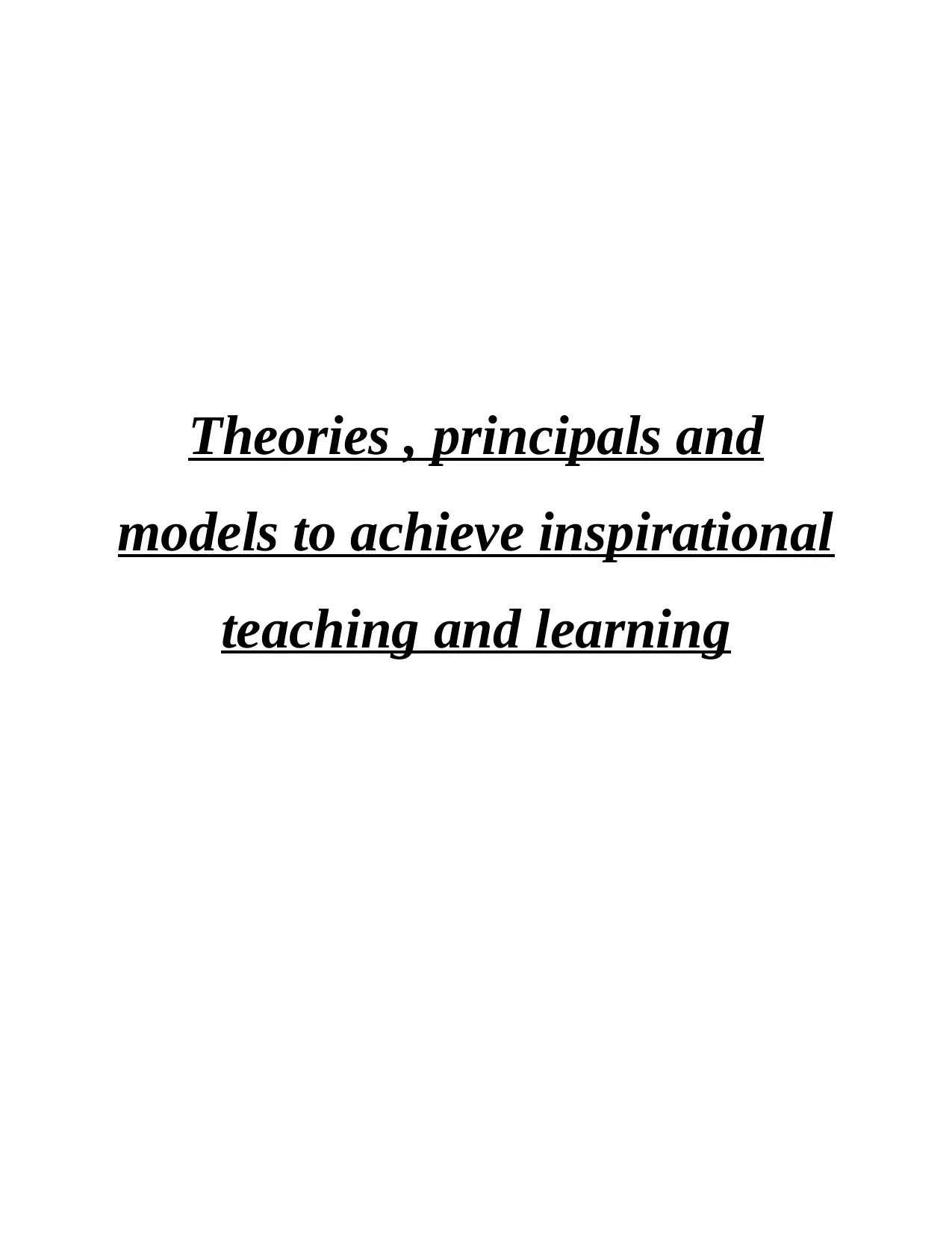
Theories , principals and
models to achieve inspirational
teaching and learning
models to achieve inspirational
teaching and learning
Paraphrase This Document
Need a fresh take? Get an instant paraphrase of this document with our AI Paraphraser
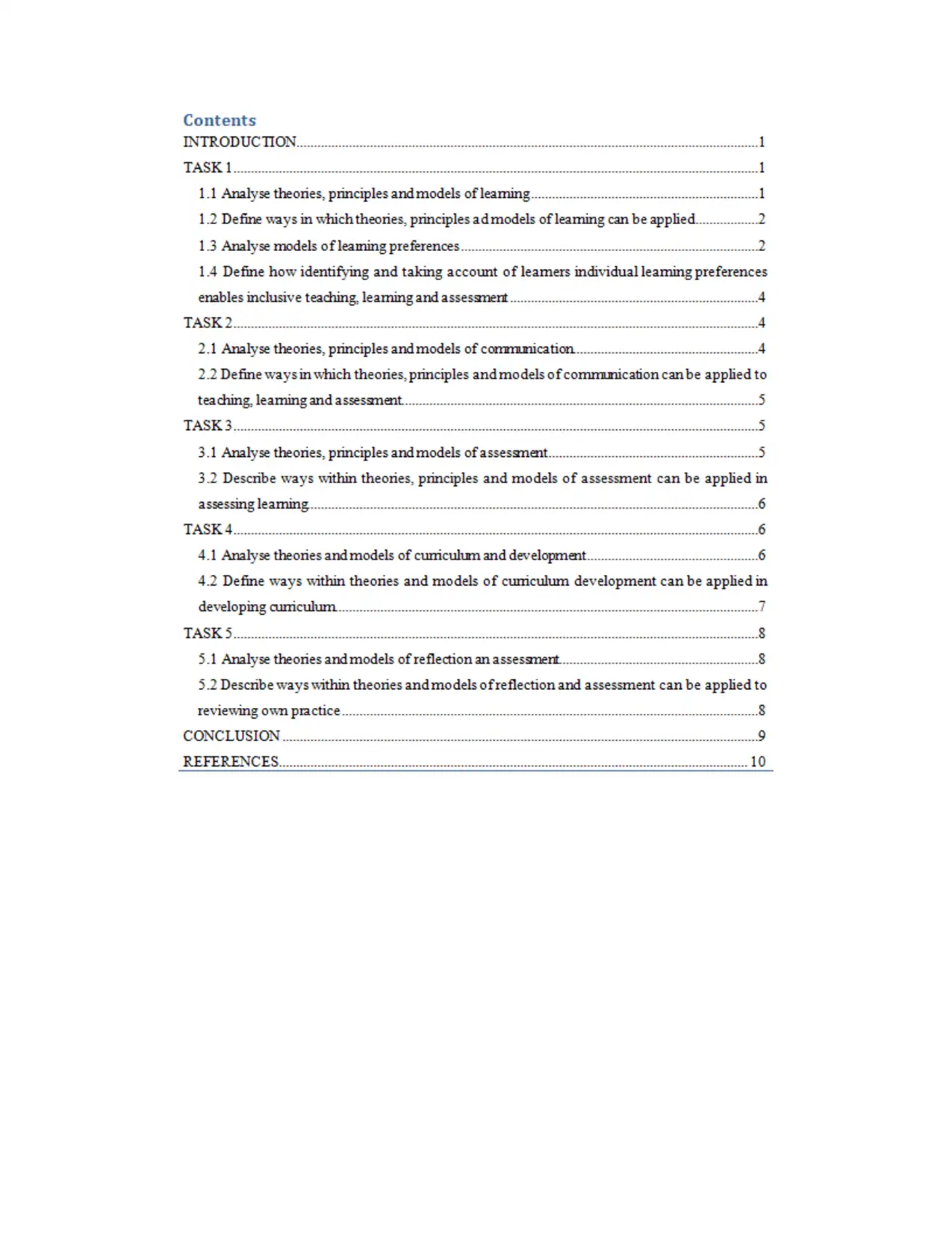
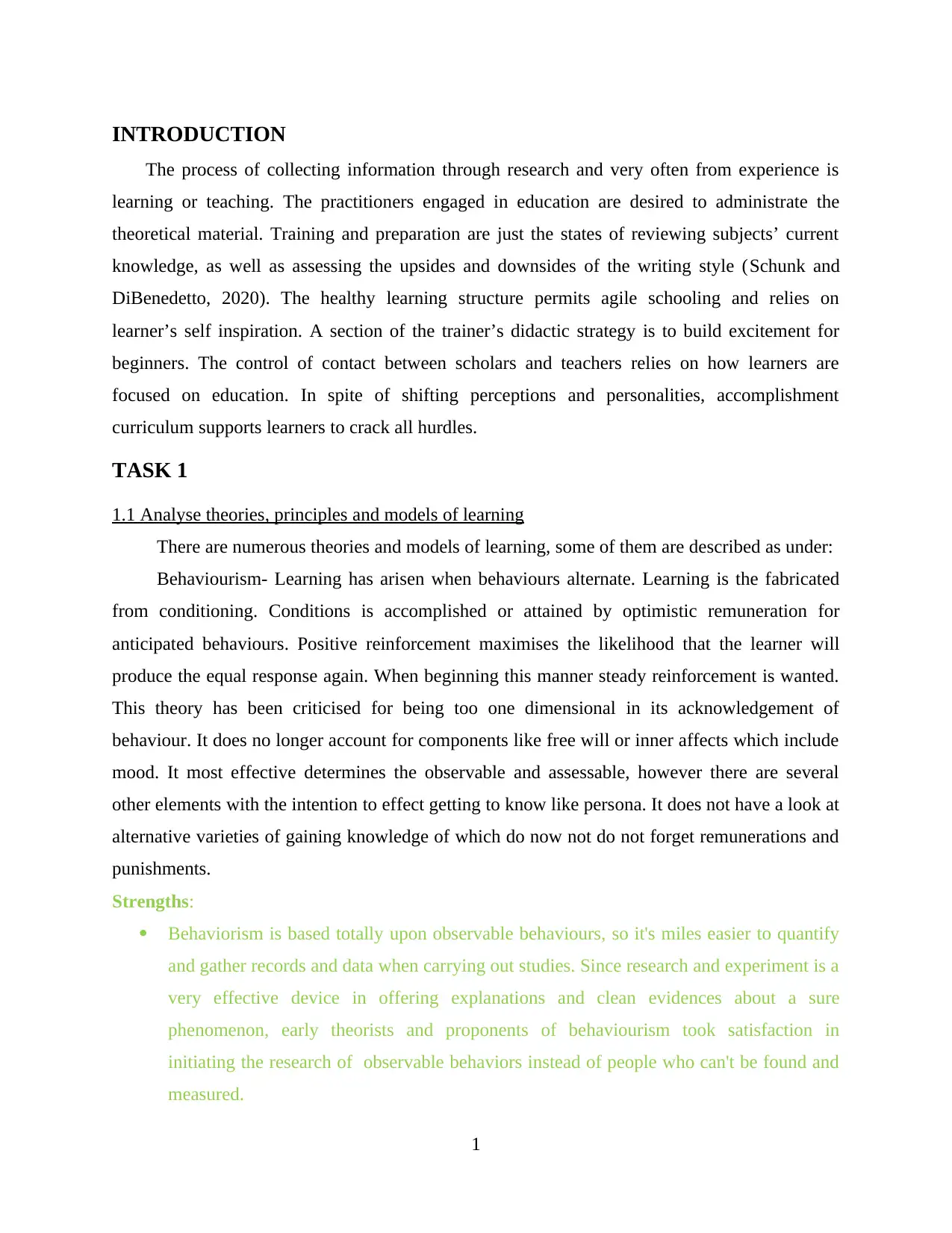
INTRODUCTION
The process of collecting information through research and very often from experience is
learning or teaching. The practitioners engaged in education are desired to administrate the
theoretical material. Training and preparation are just the states of reviewing subjects’ current
knowledge, as well as assessing the upsides and downsides of the writing style (Schunk and
DiBenedetto, 2020). The healthy learning structure permits agile schooling and relies on
learner’s self inspiration. A section of the trainer’s didactic strategy is to build excitement for
beginners. The control of contact between scholars and teachers relies on how learners are
focused on education. In spite of shifting perceptions and personalities, accomplishment
curriculum supports learners to crack all hurdles.
TASK 1
1.1 Analyse theories, principles and models of learning
There are numerous theories and models of learning, some of them are described as under:
Behaviourism- Learning has arisen when behaviours alternate. Learning is the fabricated
from conditioning. Conditions is accomplished or attained by optimistic remuneration for
anticipated behaviours. Positive reinforcement maximises the likelihood that the learner will
produce the equal response again. When beginning this manner steady reinforcement is wanted.
This theory has been criticised for being too one dimensional in its acknowledgement of
behaviour. It does no longer account for components like free will or inner affects which include
mood. It most effective determines the observable and assessable, however there are several
other elements with the intention to effect getting to know like persona. It does not have a look at
alternative varieties of gaining knowledge of which do now not do not forget remunerations and
punishments.
Strengths:
Behaviorism is based totally upon observable behaviours, so it's miles easier to quantify
and gather records and data when carrying out studies. Since research and experiment is a
very effective device in offering explanations and clean evidences about a sure
phenomenon, early theorists and proponents of behaviourism took satisfaction in
initiating the research of observable behaviors instead of people who can't be found and
measured.
1
The process of collecting information through research and very often from experience is
learning or teaching. The practitioners engaged in education are desired to administrate the
theoretical material. Training and preparation are just the states of reviewing subjects’ current
knowledge, as well as assessing the upsides and downsides of the writing style (Schunk and
DiBenedetto, 2020). The healthy learning structure permits agile schooling and relies on
learner’s self inspiration. A section of the trainer’s didactic strategy is to build excitement for
beginners. The control of contact between scholars and teachers relies on how learners are
focused on education. In spite of shifting perceptions and personalities, accomplishment
curriculum supports learners to crack all hurdles.
TASK 1
1.1 Analyse theories, principles and models of learning
There are numerous theories and models of learning, some of them are described as under:
Behaviourism- Learning has arisen when behaviours alternate. Learning is the fabricated
from conditioning. Conditions is accomplished or attained by optimistic remuneration for
anticipated behaviours. Positive reinforcement maximises the likelihood that the learner will
produce the equal response again. When beginning this manner steady reinforcement is wanted.
This theory has been criticised for being too one dimensional in its acknowledgement of
behaviour. It does no longer account for components like free will or inner affects which include
mood. It most effective determines the observable and assessable, however there are several
other elements with the intention to effect getting to know like persona. It does not have a look at
alternative varieties of gaining knowledge of which do now not do not forget remunerations and
punishments.
Strengths:
Behaviorism is based totally upon observable behaviours, so it's miles easier to quantify
and gather records and data when carrying out studies. Since research and experiment is a
very effective device in offering explanations and clean evidences about a sure
phenomenon, early theorists and proponents of behaviourism took satisfaction in
initiating the research of observable behaviors instead of people who can't be found and
measured.
1
⊘ This is a preview!⊘
Do you want full access?
Subscribe today to unlock all pages.

Trusted by 1+ million students worldwide
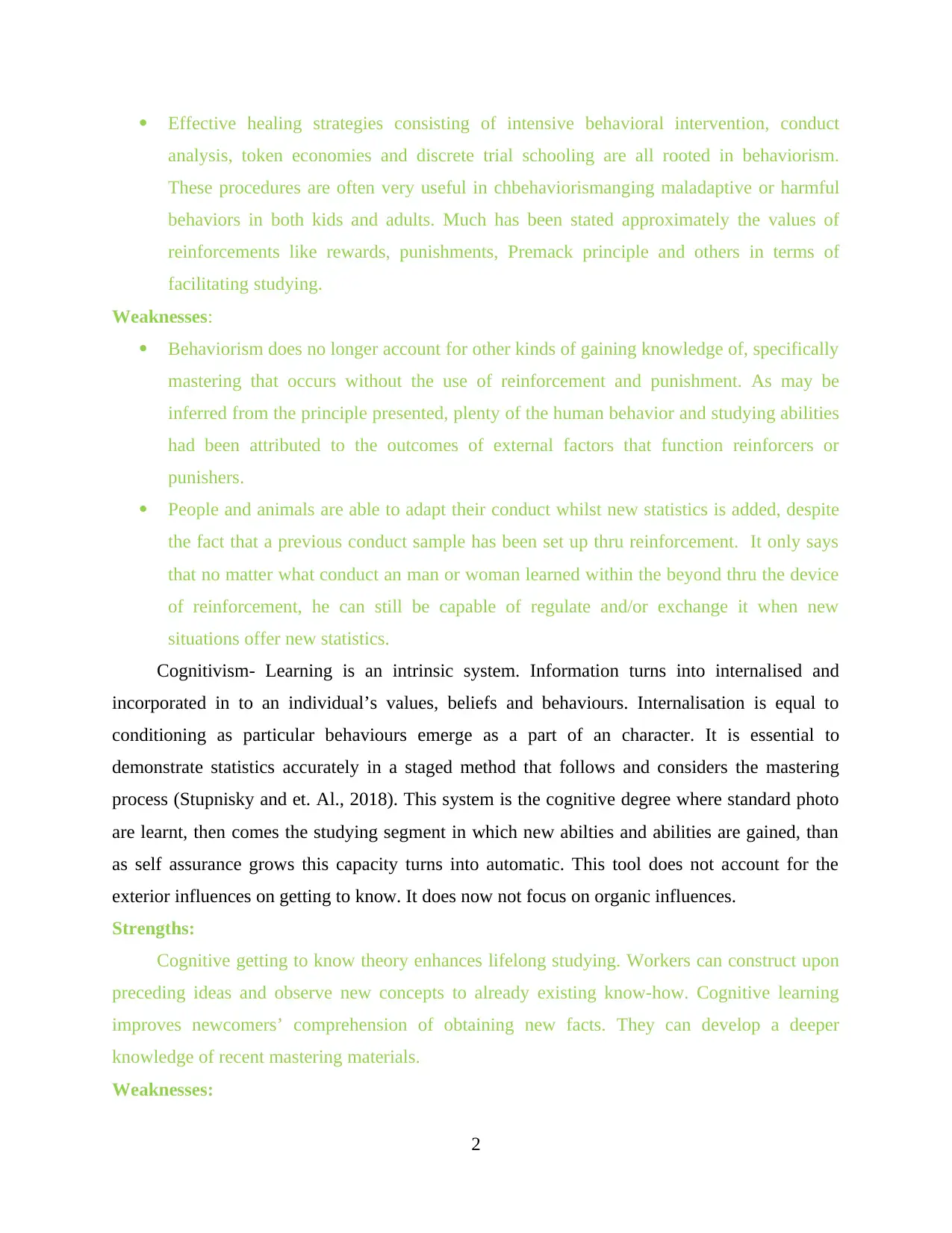
Effective healing strategies consisting of intensive behavioral intervention, conduct
analysis, token economies and discrete trial schooling are all rooted in behaviorism.
These procedures are often very useful in chbehaviorismanging maladaptive or harmful
behaviors in both kids and adults. Much has been stated approximately the values of
reinforcements like rewards, punishments, Premack principle and others in terms of
facilitating studying.
Weaknesses:
Behaviorism does no longer account for other kinds of gaining knowledge of, specifically
mastering that occurs without the use of reinforcement and punishment. As may be
inferred from the principle presented, plenty of the human behavior and studying abilities
had been attributed to the outcomes of external factors that function reinforcers or
punishers.
People and animals are able to adapt their conduct whilst new statistics is added, despite
the fact that a previous conduct sample has been set up thru reinforcement. It only says
that no matter what conduct an man or woman learned within the beyond thru the device
of reinforcement, he can still be capable of regulate and/or exchange it when new
situations offer new statistics.
Cognitivism- Learning is an intrinsic system. Information turns into internalised and
incorporated in to an individual’s values, beliefs and behaviours. Internalisation is equal to
conditioning as particular behaviours emerge as a part of an character. It is essential to
demonstrate statistics accurately in a staged method that follows and considers the mastering
process (Stupnisky and et. Al., 2018). This system is the cognitive degree where standard photo
are learnt, then comes the studying segment in which new abilties and abilities are gained, than
as self assurance grows this capacity turns into automatic. This tool does not account for the
exterior influences on getting to know. It does now not focus on organic influences.
Strengths:
Cognitive getting to know theory enhances lifelong studying. Workers can construct upon
preceding ideas and observe new concepts to already existing know-how. Cognitive learning
improves newcomers’ comprehension of obtaining new facts. They can develop a deeper
knowledge of recent mastering materials.
Weaknesses:
2
analysis, token economies and discrete trial schooling are all rooted in behaviorism.
These procedures are often very useful in chbehaviorismanging maladaptive or harmful
behaviors in both kids and adults. Much has been stated approximately the values of
reinforcements like rewards, punishments, Premack principle and others in terms of
facilitating studying.
Weaknesses:
Behaviorism does no longer account for other kinds of gaining knowledge of, specifically
mastering that occurs without the use of reinforcement and punishment. As may be
inferred from the principle presented, plenty of the human behavior and studying abilities
had been attributed to the outcomes of external factors that function reinforcers or
punishers.
People and animals are able to adapt their conduct whilst new statistics is added, despite
the fact that a previous conduct sample has been set up thru reinforcement. It only says
that no matter what conduct an man or woman learned within the beyond thru the device
of reinforcement, he can still be capable of regulate and/or exchange it when new
situations offer new statistics.
Cognitivism- Learning is an intrinsic system. Information turns into internalised and
incorporated in to an individual’s values, beliefs and behaviours. Internalisation is equal to
conditioning as particular behaviours emerge as a part of an character. It is essential to
demonstrate statistics accurately in a staged method that follows and considers the mastering
process (Stupnisky and et. Al., 2018). This system is the cognitive degree where standard photo
are learnt, then comes the studying segment in which new abilties and abilities are gained, than
as self assurance grows this capacity turns into automatic. This tool does not account for the
exterior influences on getting to know. It does now not focus on organic influences.
Strengths:
Cognitive getting to know theory enhances lifelong studying. Workers can construct upon
preceding ideas and observe new concepts to already existing know-how. Cognitive learning
improves newcomers’ comprehension of obtaining new facts. They can develop a deeper
knowledge of recent mastering materials.
Weaknesses:
2
Paraphrase This Document
Need a fresh take? Get an instant paraphrase of this document with our AI Paraphraser
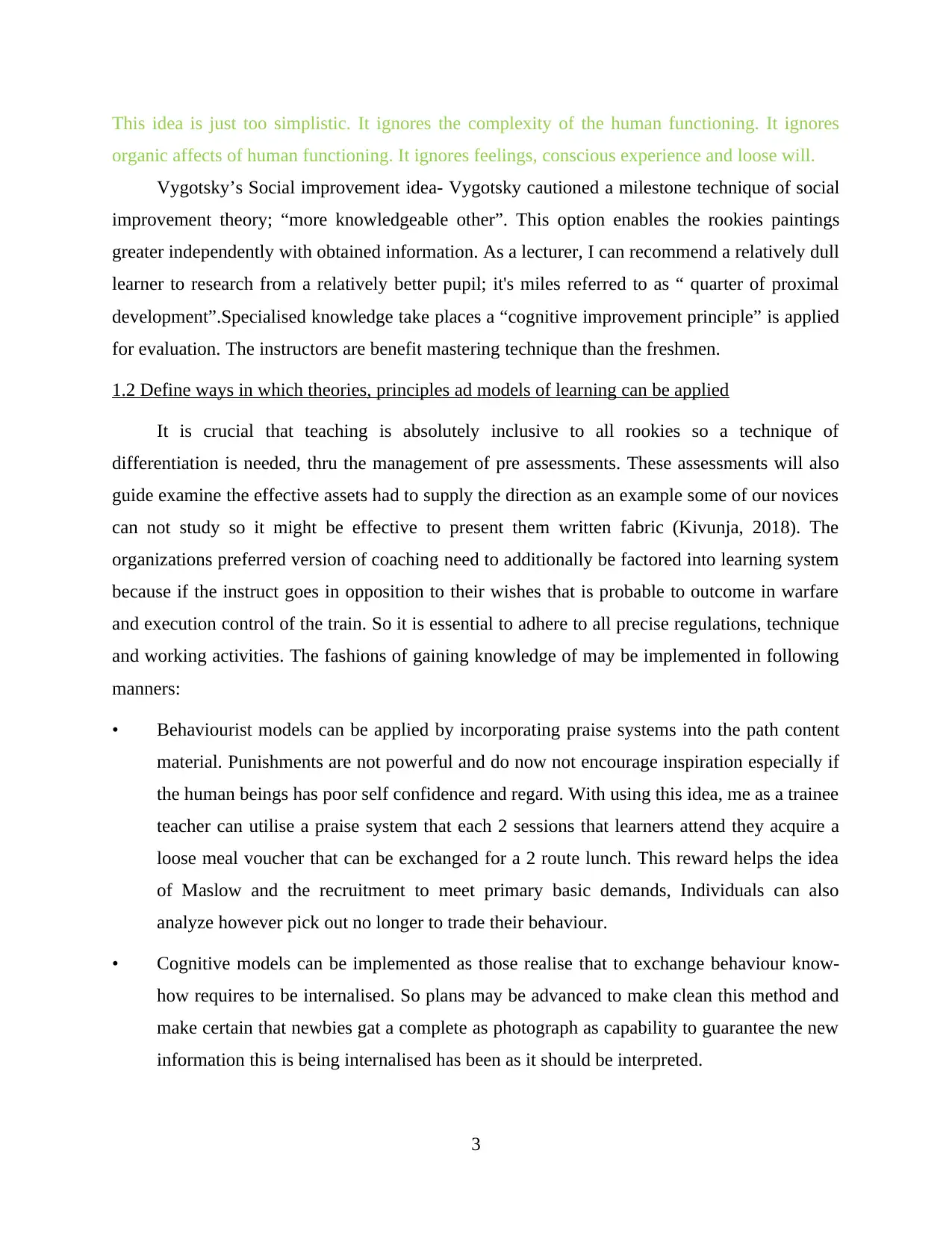
This idea is just too simplistic. It ignores the complexity of the human functioning. It ignores
organic affects of human functioning. It ignores feelings, conscious experience and loose will.
Vygotsky’s Social improvement idea- Vygotsky cautioned a milestone technique of social
improvement theory; “more knowledgeable other”. This option enables the rookies paintings
greater independently with obtained information. As a lecturer, I can recommend a relatively dull
learner to research from a relatively better pupil; it's miles referred to as “ quarter of proximal
development”.Specialised knowledge take places a “cognitive improvement principle” is applied
for evaluation. The instructors are benefit mastering technique than the freshmen.
1.2 Define ways in which theories, principles ad models of learning can be applied
It is crucial that teaching is absolutely inclusive to all rookies so a technique of
differentiation is needed, thru the management of pre assessments. These assessments will also
guide examine the effective assets had to supply the direction as an example some of our novices
can not study so it might be effective to present them written fabric (Kivunja, 2018). The
organizations preferred version of coaching need to additionally be factored into learning system
because if the instruct goes in opposition to their wishes that is probable to outcome in warfare
and execution control of the train. So it is essential to adhere to all precise regulations, technique
and working activities. The fashions of gaining knowledge of may be implemented in following
manners:
• Behaviourist models can be applied by incorporating praise systems into the path content
material. Punishments are not powerful and do now not encourage inspiration especially if
the human beings has poor self confidence and regard. With using this idea, me as a trainee
teacher can utilise a praise system that each 2 sessions that learners attend they acquire a
loose meal voucher that can be exchanged for a 2 route lunch. This reward helps the idea
of Maslow and the recruitment to meet primary basic demands, Individuals can also
analyze however pick out no longer to trade their behaviour.
• Cognitive models can be implemented as those realise that to exchange behaviour know-
how requires to be internalised. So plans may be advanced to make clean this method and
make certain that newbies gat a complete as photograph as capability to guarantee the new
information this is being internalised has been as it should be interpreted.
3
organic affects of human functioning. It ignores feelings, conscious experience and loose will.
Vygotsky’s Social improvement idea- Vygotsky cautioned a milestone technique of social
improvement theory; “more knowledgeable other”. This option enables the rookies paintings
greater independently with obtained information. As a lecturer, I can recommend a relatively dull
learner to research from a relatively better pupil; it's miles referred to as “ quarter of proximal
development”.Specialised knowledge take places a “cognitive improvement principle” is applied
for evaluation. The instructors are benefit mastering technique than the freshmen.
1.2 Define ways in which theories, principles ad models of learning can be applied
It is crucial that teaching is absolutely inclusive to all rookies so a technique of
differentiation is needed, thru the management of pre assessments. These assessments will also
guide examine the effective assets had to supply the direction as an example some of our novices
can not study so it might be effective to present them written fabric (Kivunja, 2018). The
organizations preferred version of coaching need to additionally be factored into learning system
because if the instruct goes in opposition to their wishes that is probable to outcome in warfare
and execution control of the train. So it is essential to adhere to all precise regulations, technique
and working activities. The fashions of gaining knowledge of may be implemented in following
manners:
• Behaviourist models can be applied by incorporating praise systems into the path content
material. Punishments are not powerful and do now not encourage inspiration especially if
the human beings has poor self confidence and regard. With using this idea, me as a trainee
teacher can utilise a praise system that each 2 sessions that learners attend they acquire a
loose meal voucher that can be exchanged for a 2 route lunch. This reward helps the idea
of Maslow and the recruitment to meet primary basic demands, Individuals can also
analyze however pick out no longer to trade their behaviour.
• Cognitive models can be implemented as those realise that to exchange behaviour know-
how requires to be internalised. So plans may be advanced to make clean this method and
make certain that newbies gat a complete as photograph as capability to guarantee the new
information this is being internalised has been as it should be interpreted.
3
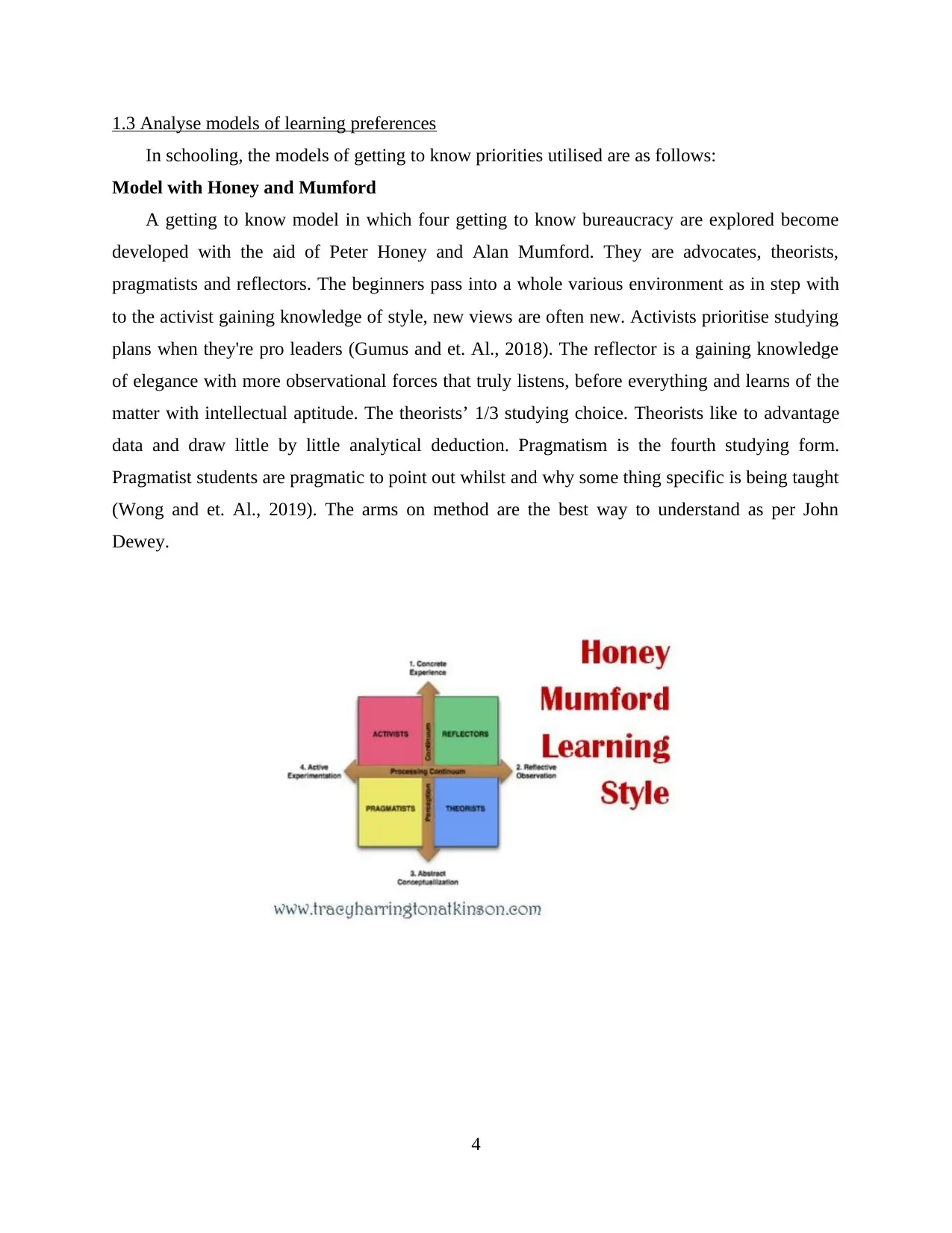
1.3 Analyse models of learning preferences
In schooling, the models of getting to know priorities utilised are as follows:
Model with Honey and Mumford
A getting to know model in which four getting to know bureaucracy are explored become
developed with the aid of Peter Honey and Alan Mumford. They are advocates, theorists,
pragmatists and reflectors. The beginners pass into a whole various environment as in step with
to the activist gaining knowledge of style, new views are often new. Activists prioritise studying
plans when they're pro leaders (Gumus and et. Al., 2018). The reflector is a gaining knowledge
of elegance with more observational forces that truly listens, before everything and learns of the
matter with intellectual aptitude. The theorists’ 1/3 studying choice. Theorists like to advantage
data and draw little by little analytical deduction. Pragmatism is the fourth studying form.
Pragmatist students are pragmatic to point out whilst and why some thing specific is being taught
(Wong and et. Al., 2019). The arms on method are the best way to understand as per John
Dewey.
4
In schooling, the models of getting to know priorities utilised are as follows:
Model with Honey and Mumford
A getting to know model in which four getting to know bureaucracy are explored become
developed with the aid of Peter Honey and Alan Mumford. They are advocates, theorists,
pragmatists and reflectors. The beginners pass into a whole various environment as in step with
to the activist gaining knowledge of style, new views are often new. Activists prioritise studying
plans when they're pro leaders (Gumus and et. Al., 2018). The reflector is a gaining knowledge
of elegance with more observational forces that truly listens, before everything and learns of the
matter with intellectual aptitude. The theorists’ 1/3 studying choice. Theorists like to advantage
data and draw little by little analytical deduction. Pragmatism is the fourth studying form.
Pragmatist students are pragmatic to point out whilst and why some thing specific is being taught
(Wong and et. Al., 2019). The arms on method are the best way to understand as per John
Dewey.
4
⊘ This is a preview!⊘
Do you want full access?
Subscribe today to unlock all pages.

Trusted by 1+ million students worldwide
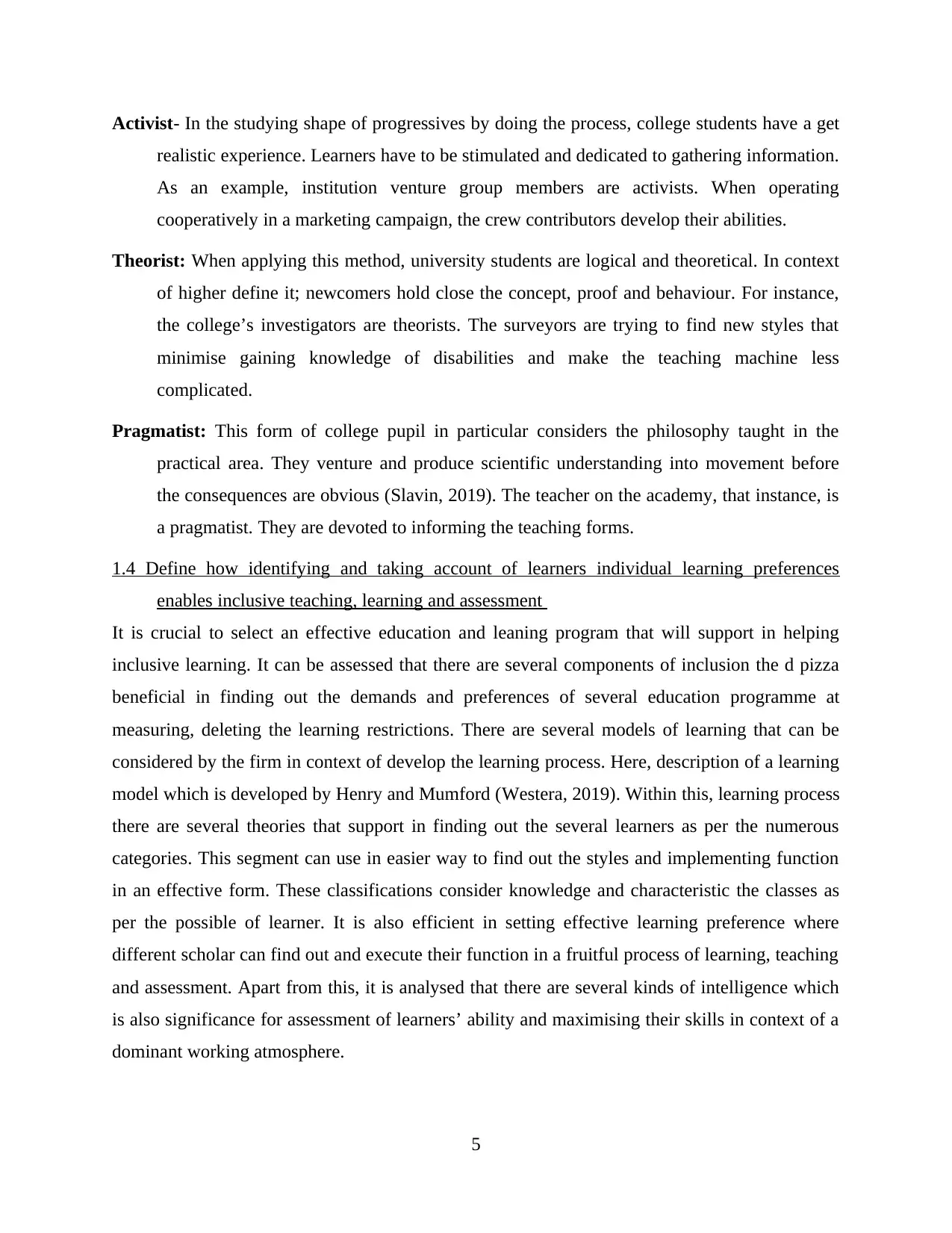
Activist- In the studying shape of progressives by doing the process, college students have a get
realistic experience. Learners have to be stimulated and dedicated to gathering information.
As an example, institution venture group members are activists. When operating
cooperatively in a marketing campaign, the crew contributors develop their abilities.
Theorist: When applying this method, university students are logical and theoretical. In context
of higher define it; newcomers hold close the concept, proof and behaviour. For instance,
the college’s investigators are theorists. The surveyors are trying to find new styles that
minimise gaining knowledge of disabilities and make the teaching machine less
complicated.
Pragmatist: This form of college pupil in particular considers the philosophy taught in the
practical area. They venture and produce scientific understanding into movement before
the consequences are obvious (Slavin, 2019). The teacher on the academy, that instance, is
a pragmatist. They are devoted to informing the teaching forms.
1.4 Define how identifying and taking account of learners individual learning preferences
enables inclusive teaching, learning and assessment
It is crucial to select an effective education and leaning program that will support in helping
inclusive learning. It can be assessed that there are several components of inclusion the d pizza
beneficial in finding out the demands and preferences of several education programme at
measuring, deleting the learning restrictions. There are several models of learning that can be
considered by the firm in context of develop the learning process. Here, description of a learning
model which is developed by Henry and Mumford (Westera, 2019). Within this, learning process
there are several theories that support in finding out the several learners as per the numerous
categories. This segment can use in easier way to find out the styles and implementing function
in an effective form. These classifications consider knowledge and characteristic the classes as
per the possible of learner. It is also efficient in setting effective learning preference where
different scholar can find out and execute their function in a fruitful process of learning, teaching
and assessment. Apart from this, it is analysed that there are several kinds of intelligence which
is also significance for assessment of learners’ ability and maximising their skills in context of a
dominant working atmosphere.
5
realistic experience. Learners have to be stimulated and dedicated to gathering information.
As an example, institution venture group members are activists. When operating
cooperatively in a marketing campaign, the crew contributors develop their abilities.
Theorist: When applying this method, university students are logical and theoretical. In context
of higher define it; newcomers hold close the concept, proof and behaviour. For instance,
the college’s investigators are theorists. The surveyors are trying to find new styles that
minimise gaining knowledge of disabilities and make the teaching machine less
complicated.
Pragmatist: This form of college pupil in particular considers the philosophy taught in the
practical area. They venture and produce scientific understanding into movement before
the consequences are obvious (Slavin, 2019). The teacher on the academy, that instance, is
a pragmatist. They are devoted to informing the teaching forms.
1.4 Define how identifying and taking account of learners individual learning preferences
enables inclusive teaching, learning and assessment
It is crucial to select an effective education and leaning program that will support in helping
inclusive learning. It can be assessed that there are several components of inclusion the d pizza
beneficial in finding out the demands and preferences of several education programme at
measuring, deleting the learning restrictions. There are several models of learning that can be
considered by the firm in context of develop the learning process. Here, description of a learning
model which is developed by Henry and Mumford (Westera, 2019). Within this, learning process
there are several theories that support in finding out the several learners as per the numerous
categories. This segment can use in easier way to find out the styles and implementing function
in an effective form. These classifications consider knowledge and characteristic the classes as
per the possible of learner. It is also efficient in setting effective learning preference where
different scholar can find out and execute their function in a fruitful process of learning, teaching
and assessment. Apart from this, it is analysed that there are several kinds of intelligence which
is also significance for assessment of learners’ ability and maximising their skills in context of a
dominant working atmosphere.
5
Paraphrase This Document
Need a fresh take? Get an instant paraphrase of this document with our AI Paraphraser
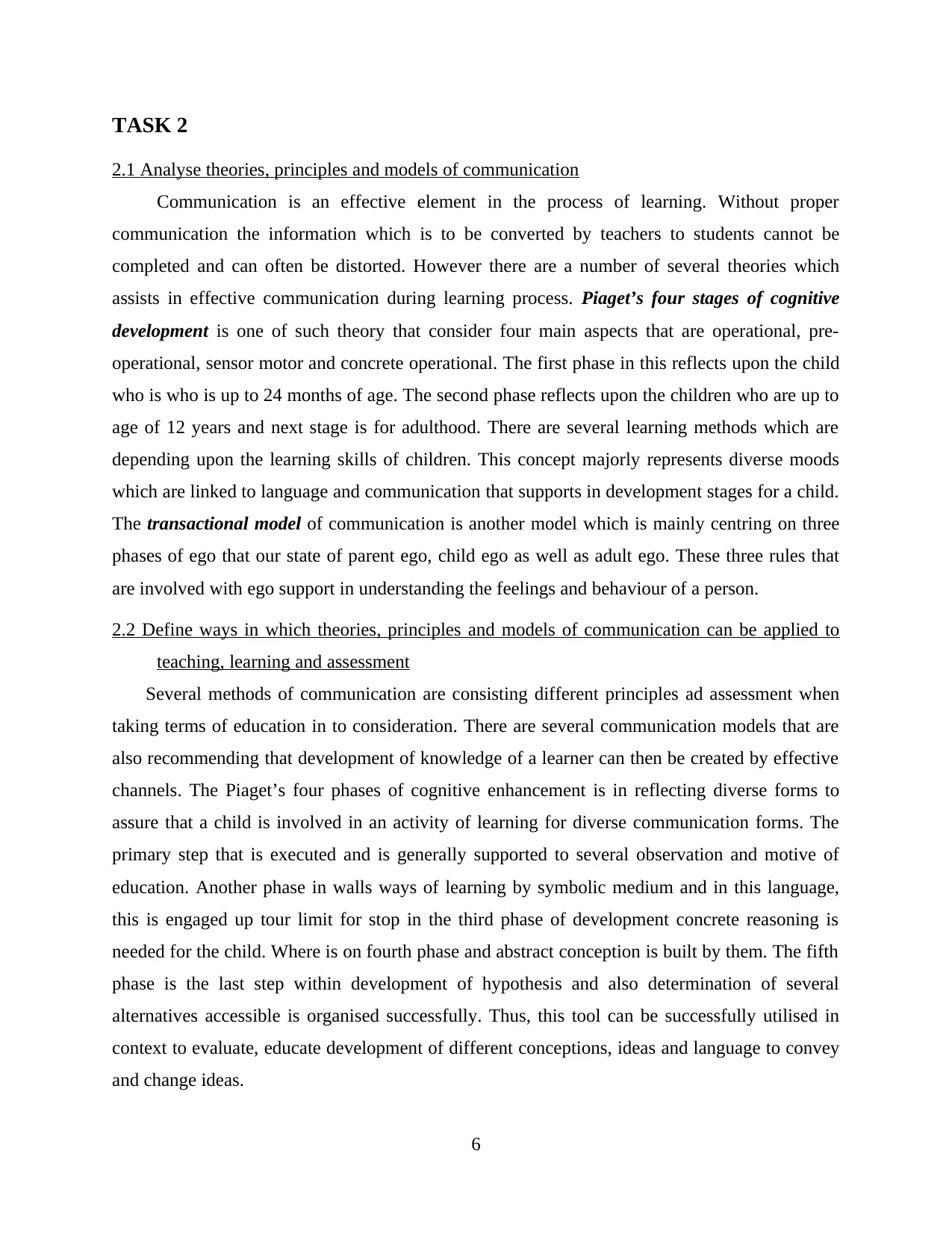
TASK 2
2.1 Analyse theories, principles and models of communication
Communication is an effective element in the process of learning. Without proper
communication the information which is to be converted by teachers to students cannot be
completed and can often be distorted. However there are a number of several theories which
assists in effective communication during learning process. Piaget’s four stages of cognitive
development is one of such theory that consider four main aspects that are operational, pre-
operational, sensor motor and concrete operational. The first phase in this reflects upon the child
who is who is up to 24 months of age. The second phase reflects upon the children who are up to
age of 12 years and next stage is for adulthood. There are several learning methods which are
depending upon the learning skills of children. This concept majorly represents diverse moods
which are linked to language and communication that supports in development stages for a child.
The transactional model of communication is another model which is mainly centring on three
phases of ego that our state of parent ego, child ego as well as adult ego. These three rules that
are involved with ego support in understanding the feelings and behaviour of a person.
2.2 Define ways in which theories, principles and models of communication can be applied to
teaching, learning and assessment
Several methods of communication are consisting different principles ad assessment when
taking terms of education in to consideration. There are several communication models that are
also recommending that development of knowledge of a learner can then be created by effective
channels. The Piaget’s four phases of cognitive enhancement is in reflecting diverse forms to
assure that a child is involved in an activity of learning for diverse communication forms. The
primary step that is executed and is generally supported to several observation and motive of
education. Another phase in walls ways of learning by symbolic medium and in this language,
this is engaged up tour limit for stop in the third phase of development concrete reasoning is
needed for the child. Where is on fourth phase and abstract conception is built by them. The fifth
phase is the last step within development of hypothesis and also determination of several
alternatives accessible is organised successfully. Thus, this tool can be successfully utilised in
context to evaluate, educate development of different conceptions, ideas and language to convey
and change ideas.
6
2.1 Analyse theories, principles and models of communication
Communication is an effective element in the process of learning. Without proper
communication the information which is to be converted by teachers to students cannot be
completed and can often be distorted. However there are a number of several theories which
assists in effective communication during learning process. Piaget’s four stages of cognitive
development is one of such theory that consider four main aspects that are operational, pre-
operational, sensor motor and concrete operational. The first phase in this reflects upon the child
who is who is up to 24 months of age. The second phase reflects upon the children who are up to
age of 12 years and next stage is for adulthood. There are several learning methods which are
depending upon the learning skills of children. This concept majorly represents diverse moods
which are linked to language and communication that supports in development stages for a child.
The transactional model of communication is another model which is mainly centring on three
phases of ego that our state of parent ego, child ego as well as adult ego. These three rules that
are involved with ego support in understanding the feelings and behaviour of a person.
2.2 Define ways in which theories, principles and models of communication can be applied to
teaching, learning and assessment
Several methods of communication are consisting different principles ad assessment when
taking terms of education in to consideration. There are several communication models that are
also recommending that development of knowledge of a learner can then be created by effective
channels. The Piaget’s four phases of cognitive enhancement is in reflecting diverse forms to
assure that a child is involved in an activity of learning for diverse communication forms. The
primary step that is executed and is generally supported to several observation and motive of
education. Another phase in walls ways of learning by symbolic medium and in this language,
this is engaged up tour limit for stop in the third phase of development concrete reasoning is
needed for the child. Where is on fourth phase and abstract conception is built by them. The fifth
phase is the last step within development of hypothesis and also determination of several
alternatives accessible is organised successfully. Thus, this tool can be successfully utilised in
context to evaluate, educate development of different conceptions, ideas and language to convey
and change ideas.
6
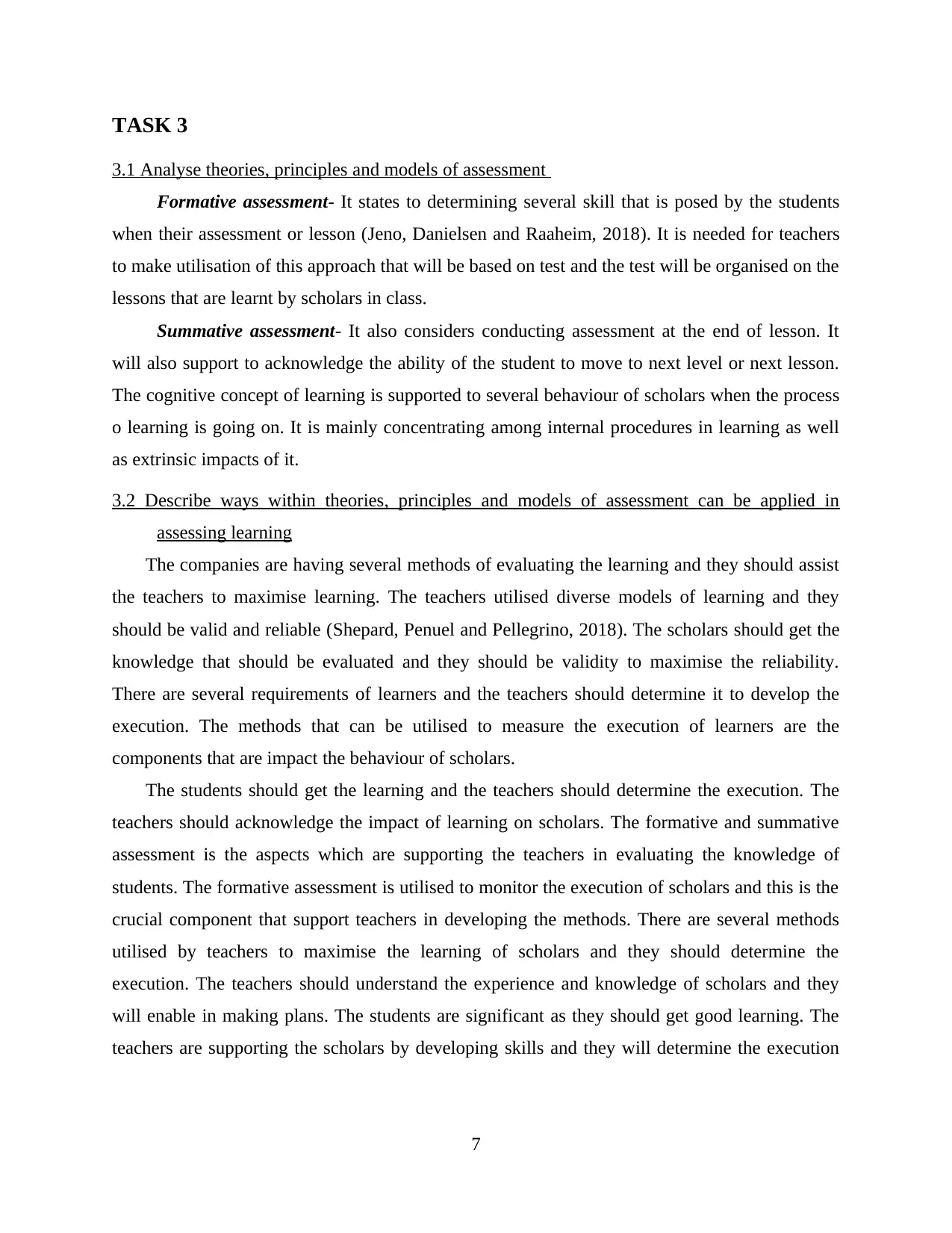
TASK 3
3.1 Analyse theories, principles and models of assessment
Formative assessment- It states to determining several skill that is posed by the students
when their assessment or lesson (Jeno, Danielsen and Raaheim, 2018). It is needed for teachers
to make utilisation of this approach that will be based on test and the test will be organised on the
lessons that are learnt by scholars in class.
Summative assessment- It also considers conducting assessment at the end of lesson. It
will also support to acknowledge the ability of the student to move to next level or next lesson.
The cognitive concept of learning is supported to several behaviour of scholars when the process
o learning is going on. It is mainly concentrating among internal procedures in learning as well
as extrinsic impacts of it.
3.2 Describe ways within theories, principles and models of assessment can be applied in
assessing learning
The companies are having several methods of evaluating the learning and they should assist
the teachers to maximise learning. The teachers utilised diverse models of learning and they
should be valid and reliable (Shepard, Penuel and Pellegrino, 2018). The scholars should get the
knowledge that should be evaluated and they should be validity to maximise the reliability.
There are several requirements of learners and the teachers should determine it to develop the
execution. The methods that can be utilised to measure the execution of learners are the
components that are impact the behaviour of scholars.
The students should get the learning and the teachers should determine the execution. The
teachers should acknowledge the impact of learning on scholars. The formative and summative
assessment is the aspects which are supporting the teachers in evaluating the knowledge of
students. The formative assessment is utilised to monitor the execution of scholars and this is the
crucial component that support teachers in developing the methods. There are several methods
utilised by teachers to maximise the learning of scholars and they should determine the
execution. The teachers should understand the experience and knowledge of scholars and they
will enable in making plans. The students are significant as they should get good learning. The
teachers are supporting the scholars by developing skills and they will determine the execution
7
3.1 Analyse theories, principles and models of assessment
Formative assessment- It states to determining several skill that is posed by the students
when their assessment or lesson (Jeno, Danielsen and Raaheim, 2018). It is needed for teachers
to make utilisation of this approach that will be based on test and the test will be organised on the
lessons that are learnt by scholars in class.
Summative assessment- It also considers conducting assessment at the end of lesson. It
will also support to acknowledge the ability of the student to move to next level or next lesson.
The cognitive concept of learning is supported to several behaviour of scholars when the process
o learning is going on. It is mainly concentrating among internal procedures in learning as well
as extrinsic impacts of it.
3.2 Describe ways within theories, principles and models of assessment can be applied in
assessing learning
The companies are having several methods of evaluating the learning and they should assist
the teachers to maximise learning. The teachers utilised diverse models of learning and they
should be valid and reliable (Shepard, Penuel and Pellegrino, 2018). The scholars should get the
knowledge that should be evaluated and they should be validity to maximise the reliability.
There are several requirements of learners and the teachers should determine it to develop the
execution. The methods that can be utilised to measure the execution of learners are the
components that are impact the behaviour of scholars.
The students should get the learning and the teachers should determine the execution. The
teachers should acknowledge the impact of learning on scholars. The formative and summative
assessment is the aspects which are supporting the teachers in evaluating the knowledge of
students. The formative assessment is utilised to monitor the execution of scholars and this is the
crucial component that support teachers in developing the methods. There are several methods
utilised by teachers to maximise the learning of scholars and they should determine the
execution. The teachers should understand the experience and knowledge of scholars and they
will enable in making plans. The students are significant as they should get good learning. The
teachers are supporting the scholars by developing skills and they will determine the execution
7
⊘ This is a preview!⊘
Do you want full access?
Subscribe today to unlock all pages.

Trusted by 1+ million students worldwide
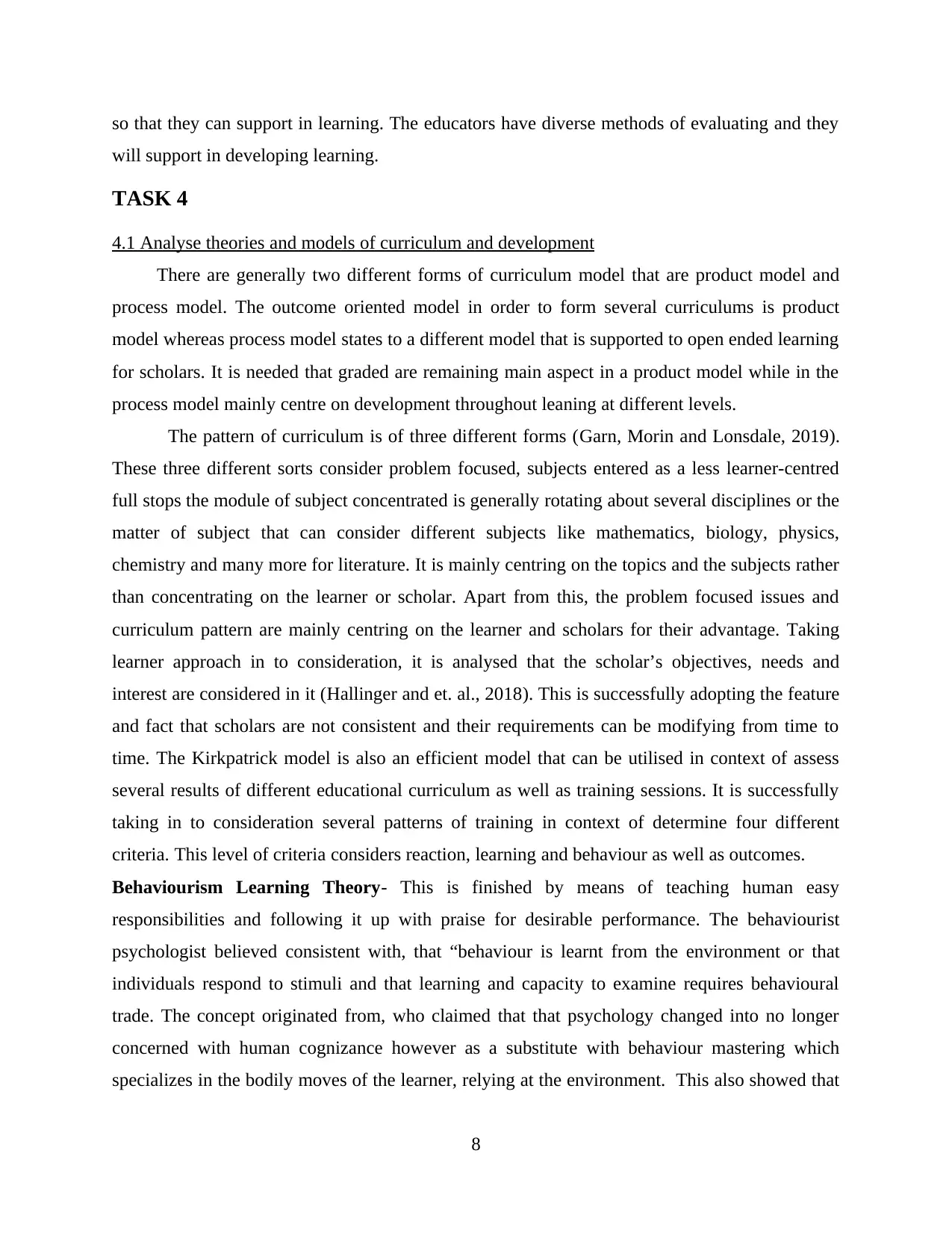
so that they can support in learning. The educators have diverse methods of evaluating and they
will support in developing learning.
TASK 4
4.1 Analyse theories and models of curriculum and development
There are generally two different forms of curriculum model that are product model and
process model. The outcome oriented model in order to form several curriculums is product
model whereas process model states to a different model that is supported to open ended learning
for scholars. It is needed that graded are remaining main aspect in a product model while in the
process model mainly centre on development throughout leaning at different levels.
The pattern of curriculum is of three different forms (Garn, Morin and Lonsdale, 2019).
These three different sorts consider problem focused, subjects entered as a less learner-centred
full stops the module of subject concentrated is generally rotating about several disciplines or the
matter of subject that can consider different subjects like mathematics, biology, physics,
chemistry and many more for literature. It is mainly centring on the topics and the subjects rather
than concentrating on the learner or scholar. Apart from this, the problem focused issues and
curriculum pattern are mainly centring on the learner and scholars for their advantage. Taking
learner approach in to consideration, it is analysed that the scholar’s objectives, needs and
interest are considered in it (Hallinger and et. al., 2018). This is successfully adopting the feature
and fact that scholars are not consistent and their requirements can be modifying from time to
time. The Kirkpatrick model is also an efficient model that can be utilised in context of assess
several results of different educational curriculum as well as training sessions. It is successfully
taking in to consideration several patterns of training in context of determine four different
criteria. This level of criteria considers reaction, learning and behaviour as well as outcomes.
Behaviourism Learning Theory- This is finished by means of teaching human easy
responsibilities and following it up with praise for desirable performance. The behaviourist
psychologist believed consistent with, that “behaviour is learnt from the environment or that
individuals respond to stimuli and that learning and capacity to examine requires behavioural
trade. The concept originated from, who claimed that that psychology changed into no longer
concerned with human cognizance however as a substitute with behaviour mastering which
specializes in the bodily moves of the learner, relying at the environment. This also showed that
8
will support in developing learning.
TASK 4
4.1 Analyse theories and models of curriculum and development
There are generally two different forms of curriculum model that are product model and
process model. The outcome oriented model in order to form several curriculums is product
model whereas process model states to a different model that is supported to open ended learning
for scholars. It is needed that graded are remaining main aspect in a product model while in the
process model mainly centre on development throughout leaning at different levels.
The pattern of curriculum is of three different forms (Garn, Morin and Lonsdale, 2019).
These three different sorts consider problem focused, subjects entered as a less learner-centred
full stops the module of subject concentrated is generally rotating about several disciplines or the
matter of subject that can consider different subjects like mathematics, biology, physics,
chemistry and many more for literature. It is mainly centring on the topics and the subjects rather
than concentrating on the learner or scholar. Apart from this, the problem focused issues and
curriculum pattern are mainly centring on the learner and scholars for their advantage. Taking
learner approach in to consideration, it is analysed that the scholar’s objectives, needs and
interest are considered in it (Hallinger and et. al., 2018). This is successfully adopting the feature
and fact that scholars are not consistent and their requirements can be modifying from time to
time. The Kirkpatrick model is also an efficient model that can be utilised in context of assess
several results of different educational curriculum as well as training sessions. It is successfully
taking in to consideration several patterns of training in context of determine four different
criteria. This level of criteria considers reaction, learning and behaviour as well as outcomes.
Behaviourism Learning Theory- This is finished by means of teaching human easy
responsibilities and following it up with praise for desirable performance. The behaviourist
psychologist believed consistent with, that “behaviour is learnt from the environment or that
individuals respond to stimuli and that learning and capacity to examine requires behavioural
trade. The concept originated from, who claimed that that psychology changed into no longer
concerned with human cognizance however as a substitute with behaviour mastering which
specializes in the bodily moves of the learner, relying at the environment. This also showed that
8
Paraphrase This Document
Need a fresh take? Get an instant paraphrase of this document with our AI Paraphraser
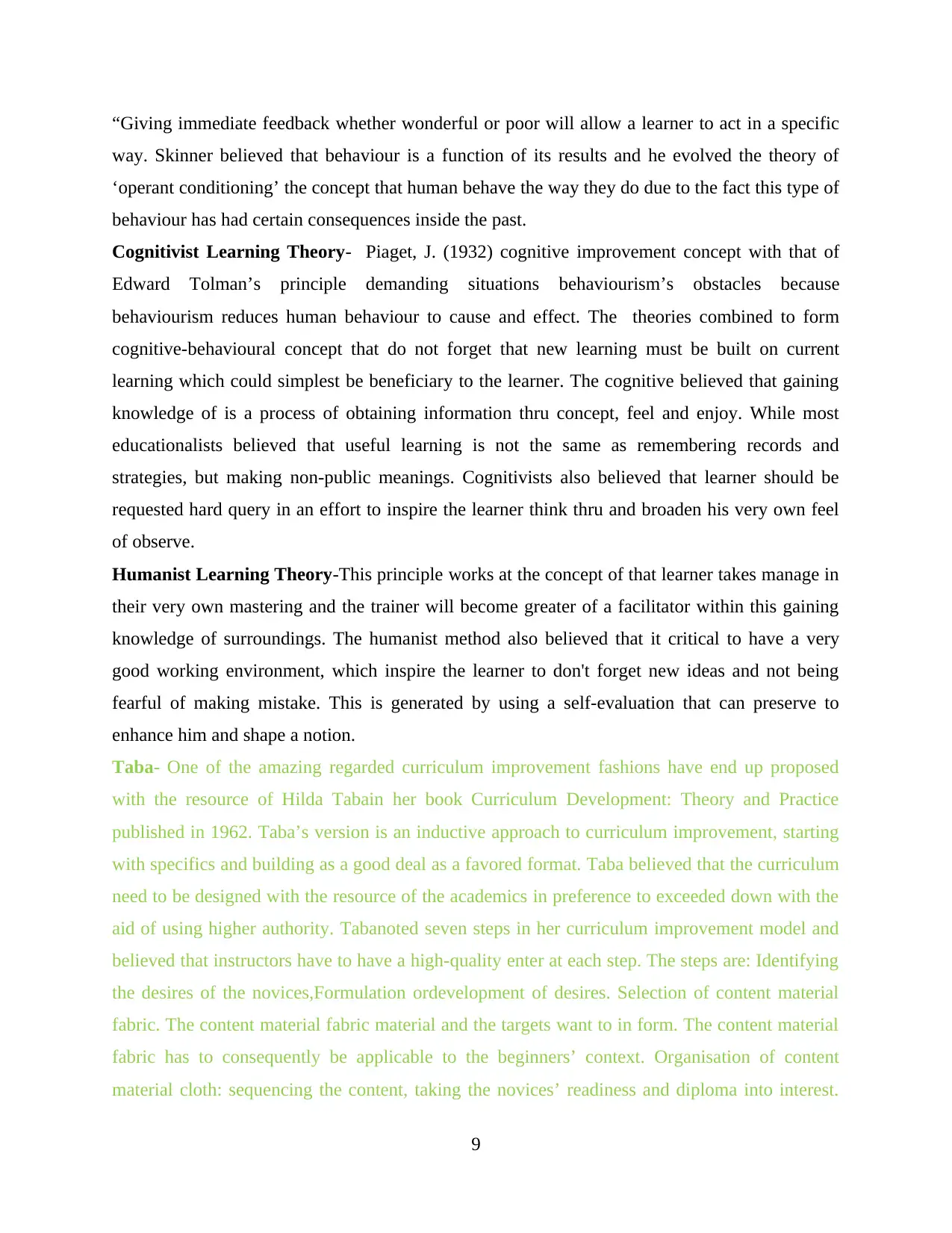
“Giving immediate feedback whether wonderful or poor will allow a learner to act in a specific
way. Skinner believed that behaviour is a function of its results and he evolved the theory of
‘operant conditioning’ the concept that human behave the way they do due to the fact this type of
behaviour has had certain consequences inside the past.
Cognitivist Learning Theory- Piaget, J. (1932) cognitive improvement concept with that of
Edward Tolman’s principle demanding situations behaviourism’s obstacles because
behaviourism reduces human behaviour to cause and effect. The theories combined to form
cognitive-behavioural concept that do not forget that new learning must be built on current
learning which could simplest be beneficiary to the learner. The cognitive believed that gaining
knowledge of is a process of obtaining information thru concept, feel and enjoy. While most
educationalists believed that useful learning is not the same as remembering records and
strategies, but making non-public meanings. Cognitivists also believed that learner should be
requested hard query in an effort to inspire the learner think thru and broaden his very own feel
of observe.
Humanist Learning Theory-This principle works at the concept of that learner takes manage in
their very own mastering and the trainer will become greater of a facilitator within this gaining
knowledge of surroundings. The humanist method also believed that it critical to have a very
good working environment, which inspire the learner to don't forget new ideas and not being
fearful of making mistake. This is generated by using a self-evaluation that can preserve to
enhance him and shape a notion.
Taba- One of the amazing regarded curriculum improvement fashions have end up proposed
with the resource of Hilda Tabain her book Curriculum Development: Theory and Practice
published in 1962. Taba’s version is an inductive approach to curriculum improvement, starting
with specifics and building as a good deal as a favored format. Taba believed that the curriculum
need to be designed with the resource of the academics in preference to exceeded down with the
aid of using higher authority. Tabanoted seven steps in her curriculum improvement model and
believed that instructors have to have a high-quality enter at each step. The steps are: Identifying
the desires of the novices,Formulation ordevelopment of desires. Selection of content material
fabric. The content material fabric material and the targets want to in form. The content material
fabric has to consequently be applicable to the beginners’ context. Organisation of content
material cloth: sequencing the content, taking the novices’ readiness and diploma into interest.
9
way. Skinner believed that behaviour is a function of its results and he evolved the theory of
‘operant conditioning’ the concept that human behave the way they do due to the fact this type of
behaviour has had certain consequences inside the past.
Cognitivist Learning Theory- Piaget, J. (1932) cognitive improvement concept with that of
Edward Tolman’s principle demanding situations behaviourism’s obstacles because
behaviourism reduces human behaviour to cause and effect. The theories combined to form
cognitive-behavioural concept that do not forget that new learning must be built on current
learning which could simplest be beneficiary to the learner. The cognitive believed that gaining
knowledge of is a process of obtaining information thru concept, feel and enjoy. While most
educationalists believed that useful learning is not the same as remembering records and
strategies, but making non-public meanings. Cognitivists also believed that learner should be
requested hard query in an effort to inspire the learner think thru and broaden his very own feel
of observe.
Humanist Learning Theory-This principle works at the concept of that learner takes manage in
their very own mastering and the trainer will become greater of a facilitator within this gaining
knowledge of surroundings. The humanist method also believed that it critical to have a very
good working environment, which inspire the learner to don't forget new ideas and not being
fearful of making mistake. This is generated by using a self-evaluation that can preserve to
enhance him and shape a notion.
Taba- One of the amazing regarded curriculum improvement fashions have end up proposed
with the resource of Hilda Tabain her book Curriculum Development: Theory and Practice
published in 1962. Taba’s version is an inductive approach to curriculum improvement, starting
with specifics and building as a good deal as a favored format. Taba believed that the curriculum
need to be designed with the resource of the academics in preference to exceeded down with the
aid of using higher authority. Tabanoted seven steps in her curriculum improvement model and
believed that instructors have to have a high-quality enter at each step. The steps are: Identifying
the desires of the novices,Formulation ordevelopment of desires. Selection of content material
fabric. The content material fabric material and the targets want to in form. The content material
fabric has to consequently be applicable to the beginners’ context. Organisation of content
material cloth: sequencing the content, taking the novices’ readiness and diploma into interest.
9
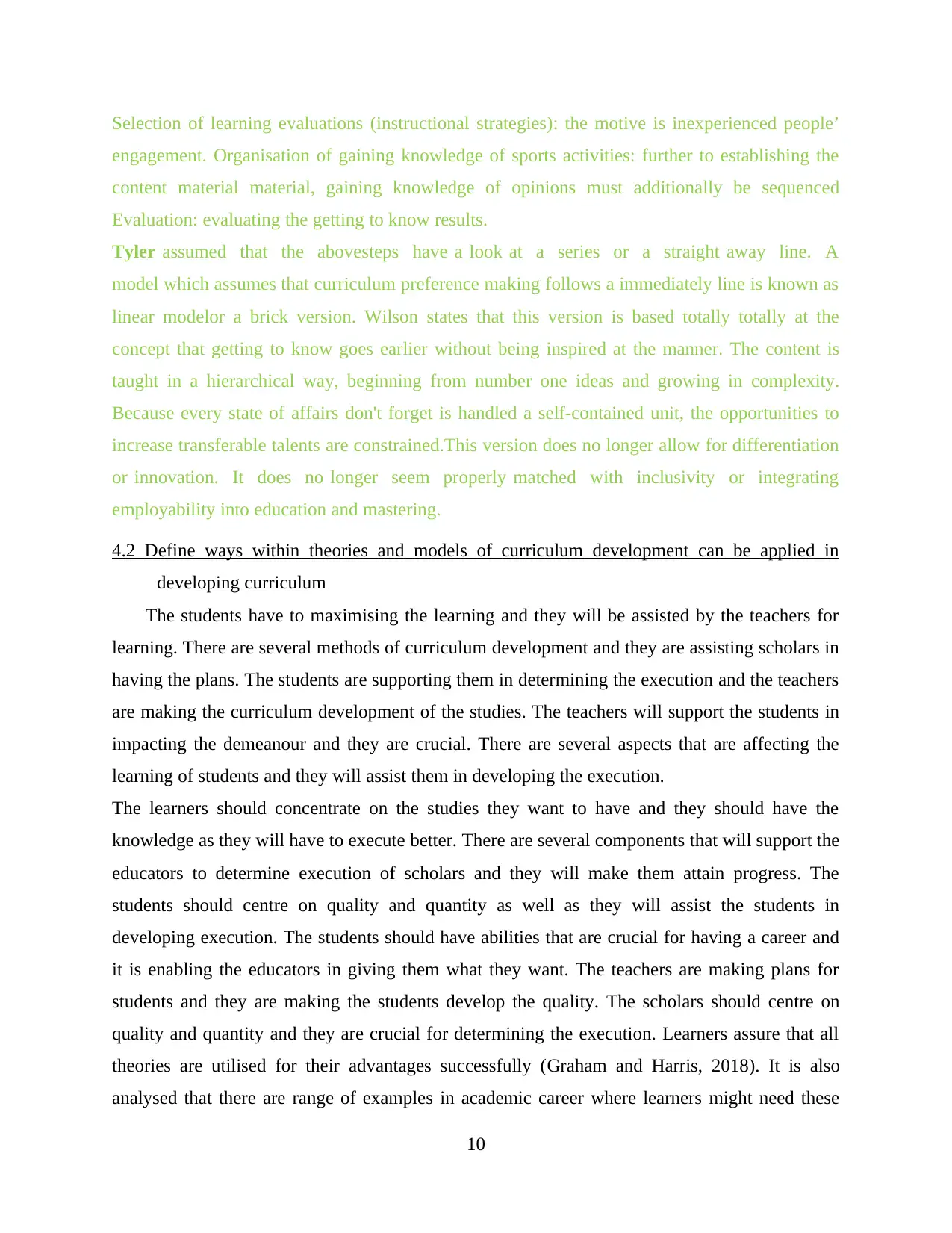
Selection of learning evaluations (instructional strategies): the motive is inexperienced people’
engagement. Organisation of gaining knowledge of sports activities: further to establishing the
content material material, gaining knowledge of opinions must additionally be sequenced
Evaluation: evaluating the getting to know results.
Tyler assumed that the abovesteps have a look at a series or a straight away line. A
model which assumes that curriculum preference making follows a immediately line is known as
linear modelor a brick version. Wilson states that this version is based totally totally at the
concept that getting to know goes earlier without being inspired at the manner. The content is
taught in a hierarchical way, beginning from number one ideas and growing in complexity.
Because every state of affairs don't forget is handled a self-contained unit, the opportunities to
increase transferable talents are constrained.This version does no longer allow for differentiation
or innovation. It does no longer seem properly matched with inclusivity or integrating
employability into education and mastering.
4.2 Define ways within theories and models of curriculum development can be applied in
developing curriculum
The students have to maximising the learning and they will be assisted by the teachers for
learning. There are several methods of curriculum development and they are assisting scholars in
having the plans. The students are supporting them in determining the execution and the teachers
are making the curriculum development of the studies. The teachers will support the students in
impacting the demeanour and they are crucial. There are several aspects that are affecting the
learning of students and they will assist them in developing the execution.
The learners should concentrate on the studies they want to have and they should have the
knowledge as they will have to execute better. There are several components that will support the
educators to determine execution of scholars and they will make them attain progress. The
students should centre on quality and quantity as well as they will assist the students in
developing execution. The students should have abilities that are crucial for having a career and
it is enabling the educators in giving them what they want. The teachers are making plans for
students and they are making the students develop the quality. The scholars should centre on
quality and quantity and they are crucial for determining the execution. Learners assure that all
theories are utilised for their advantages successfully (Graham and Harris, 2018). It is also
analysed that there are range of examples in academic career where learners might need these
10
engagement. Organisation of gaining knowledge of sports activities: further to establishing the
content material material, gaining knowledge of opinions must additionally be sequenced
Evaluation: evaluating the getting to know results.
Tyler assumed that the abovesteps have a look at a series or a straight away line. A
model which assumes that curriculum preference making follows a immediately line is known as
linear modelor a brick version. Wilson states that this version is based totally totally at the
concept that getting to know goes earlier without being inspired at the manner. The content is
taught in a hierarchical way, beginning from number one ideas and growing in complexity.
Because every state of affairs don't forget is handled a self-contained unit, the opportunities to
increase transferable talents are constrained.This version does no longer allow for differentiation
or innovation. It does no longer seem properly matched with inclusivity or integrating
employability into education and mastering.
4.2 Define ways within theories and models of curriculum development can be applied in
developing curriculum
The students have to maximising the learning and they will be assisted by the teachers for
learning. There are several methods of curriculum development and they are assisting scholars in
having the plans. The students are supporting them in determining the execution and the teachers
are making the curriculum development of the studies. The teachers will support the students in
impacting the demeanour and they are crucial. There are several aspects that are affecting the
learning of students and they will assist them in developing the execution.
The learners should concentrate on the studies they want to have and they should have the
knowledge as they will have to execute better. There are several components that will support the
educators to determine execution of scholars and they will make them attain progress. The
students should centre on quality and quantity as well as they will assist the students in
developing execution. The students should have abilities that are crucial for having a career and
it is enabling the educators in giving them what they want. The teachers are making plans for
students and they are making the students develop the quality. The scholars should centre on
quality and quantity and they are crucial for determining the execution. Learners assure that all
theories are utilised for their advantages successfully (Graham and Harris, 2018). It is also
analysed that there are range of examples in academic career where learners might need these
10
⊘ This is a preview!⊘
Do you want full access?
Subscribe today to unlock all pages.

Trusted by 1+ million students worldwide
1 out of 16
Related Documents
Your All-in-One AI-Powered Toolkit for Academic Success.
+13062052269
info@desklib.com
Available 24*7 on WhatsApp / Email
![[object Object]](/_next/static/media/star-bottom.7253800d.svg)
Unlock your academic potential
Copyright © 2020–2025 A2Z Services. All Rights Reserved. Developed and managed by ZUCOL.





